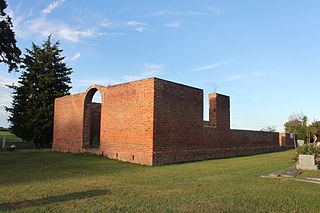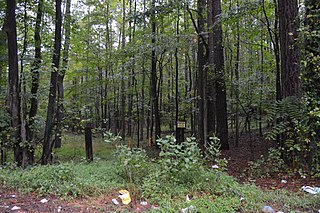
New Utrecht Reformed Church is the fourth oldest Reformed Church in America congregation and is located in Bensonhurst, Brooklyn, New York. The church was established in 1677 by ethnic Dutch residents in the town of New Utrecht, Brooklyn, several years after the English took over New Netherland. It is affiliated with the Reformed Church in America, a Protestant denomination. The cemetery was consecrated in 1654; 1300 dead are interred there. The Liberty Pole, the sixth on the site of the present church, was originally erected in 1783 at the end of the Revolutionary War to harass departing British troops.

The Garden District is a neighborhood of the city of New Orleans, Louisiana, United States. A subdistrict of the Central City/Garden District Area, its boundaries as defined by the New Orleans City Planning Commission are: St. Charles Avenue to the north, 1st Street to the east, Magazine Street to the south, and Toledano Street to the west. The National Historic Landmark district extends a little farther.

Toano, formerly Burnt Ordinary, is an unincorporated community in James City County, Virginia, United States. It is in Virginia’s 1st Congressional District.

The Texas Historical Commission is an agency dedicated to historic preservation within the state of Texas. It administers the National Register of Historic Places for sites in Texas.

Bacon's Castle, also variously known as "Allen's Brick House" or the "Arthur Allen House" is located in Surry County, Virginia, United States, and is the oldest documented brick dwelling in what is now the United States. Built in 1665, it is noted as an extremely rare example of Jacobean architecture in the New World.

Buildings, sites, districts, and objects in Virginia listed on the National Register of Historic Places:

Historic Jamestown is the cultural heritage site that was the location of the 1607 James Fort and the later 17th-century town of Jamestown in America. It is located on Jamestown Island, on the James River at Jamestown, Virginia and operated as a partnership between Preservation Virginia and the U.S. National Park Service as part of Colonial National Historical Park.

Aquia Church is a historic church and congregation at 2938 Richmond Highway in Stafford, Virginia, USA. It is an Episcopal congregation founded in 1711, that meets in an architecturally exceptional Georgian brick building that was built in the 1750s. The building was designated a National Historic Landmark in 1991 for its architectural importance. It maintains an active congregation with a variety of programs and outreach to the community.

The Glebe House, built in 1854–1857, is a historic house with an octagon-shaped wing in Arlington County, Virginia. The Northern Virginia Conservation Trust holds a conservation easement to help protect and preserve it. The name of the house comes from the property's history as a glebe, an area of land within an ecclesiastical parish used to support a parish priest. In this case, the glebe was established by the Church of England before the American Revolutionary War.

St. John's is an Episcopal church located in Hampton, Virginia, United States, within the Episcopal Diocese of Southern Virginia. Established in 1610, St. John's is the oldest English-speaking parish in continuous existence in the United States of America.

Old Brick Church variously known as the Lawnes Creek Parish Church or the Lower Surry Church is a historic church in Bacon's Castle, Virginia.

The Emmanuel Church at Brook Hill, in the historic community of Brook Hill in Henrico County, Virginia, is a historic Episcopal church.

St. Stephen's Church, also known as St. Stephen's Episcopal Church, is an historic church located at 6807 Northumberland Highway, Heathsville, Northumberland County, in the Northern Neck of Virginia. Built in 1881, it was designed in the Carpenter Gothic style by T. Buckler Ghequiere. On December 28, 1979, it was added to the National Register of Historic Places. It remains in use by an active parish in the Episcopal Diocese of Virginia. It is located in the Heathsville Historic District.

The Second Union School is a historic Rosenwald school building for African-American children located near Fife, in western Goochland County, Virginia. It was built in 1918, as a two-teacher school, near Second Union Baptist Church, which had been founded in 1865 as an independent black congregation.

White Post Historic District is a national historic district located at White Post, Clarke County, Virginia. It encompasses 23 contributing buildings and 1 contributing object in the crossroads village of White Post. The contributing object is the white-painted marker which Thomas, Sixth Lord Fairfax, had erected in the 1760s to point the way to Greenway Court, his nearby estate.
Accokeek Furnace Archeological Site is a historic archaeological site located near Stafford, Stafford County, Virginia. The Principio Company of Cecil County, Maryland, constructed the Accokeek Iron Furnace about 1726 on land leased from Augustine Washington, father of George Washington. After his death in 1743, his son Lawrence Washington inherited his interest in the company and furnace. When he died in 1752, his share descended to his brother Augustine Washington, Jr. Operations at this site ceased around 1753. A historical marker denoting this site is located on the grounds of Colonial Forge High School.

Glebe House of Southwark Parish, also known as The Old Glebe, is a historic glebe house located near Spring Grove, Surry County, Virginia. It was built about 1724, and is a 1+1⁄2-story, three bay, single pile, central-hall plan brick dwelling. It has a gambrel roof with dormers, added in the 19th century, has exterior end chimneys, and sits on a brick basement. Also on the property is a contributing frame smokehouse. The glebe house was sold, as required by the legislature during the Disestablishment of 1802. It was subsequently remodeled and used as a private dwelling.It sits on the site of Indian Spring Plantation patented by Nicholas Merriweather in 1666. The property is currently owned by the Perkins family.

Bruton Parish Poorhouse Archeological Site is a historic archaeological site located near Williamsburg, York County, Virginia. It is the site of a poorhouse established by Bruton Parish Church after a 1755 act of the assembly empowering all the colony's parishes to erect poorhouses. An excavation in 1978 by the Virginia Department of Historic Resources revealed the foundations of one of four poorhouse buildings identified by the French cartographer Desandrouin in 1781–1782.
William Gooch Tomb and York Village Archeological Site is a historic archaeological site located near Yorktown, York County, Virginia. It is the site of York Village established on the York River near Wormley Creek before 1635. A church was constructed at York about 1638. In 1655, Maj. William Gooch, uncle of Sir William Gooch, 1st Baronet, was buried within the church walls. His armorial slab is one of the oldest interpretable tombstones in Virginia. The village was abandoned by the end of the 18th century. The site is located on the U.S. Coast Guard Reserve Training Center and marked by a small park.

First Denbigh Parish Church Archeological Site is a historic archaeological site located at Newport News, Virginia. The site is located on the bluff overlooking the Warwick River at the mouth of Church Creek. It took its name from nearby Denbigh Plantation and was constructed in 1636. A new structure was built at a nearby site by 1686 and replaced the former building. A frame structure for Warwick Parish was built on the site about 1774 and the Baptists began using it by 1834.






















